
Note: The illustrations of the camera in this manual do not exactly match the actual FED BOY production camera. In particular, the manual shows the logo, "FED Stereo" in cyrillic, while the actual production camera bears the label "FED BOY Stereo".

The stereoscopic photography will discover for you a new world of exciting and creative activity. Three-dimensional colour images will produce for you a vivid effect of presence in scene. The stereoscopic camera "FED-stereo" (hereinafter referred to as camera) is designed to permit the amateurs to take stereoscopic photographs in quantity of 21 stereoscopic couples with the exposure size of 24x30 mm on a standard 35 mm photographic film.
The camera is manufactured in two models: "FED-stereo M" and "FED B-O-Y stereo".
"FED B-O-Y stereo" differs by the following:
Reversal and negative black-and-white or colour film can be used when taking stereoscopic photographs.
A photographer may use a developed reversal film to make stereoscopic slides, the purchased or self-made stereoscopic frames being used for this purpose. A negative film can be used to make pictures on photographic paper to use them as photographs of a common type or stereoscopic couples.
Speaking a little about stereoscopic photography.
Two identical lenses in the camera permit a photographer to make two discriminated flat images on a film, these two images forming a stereoscopic couple which can be projected on a screen through the use of the stereoscopic diascope "ETUDE-stereo" thus producing a three-dimensional image picture.
In fact, a man sees the surrounding objects in as much a similar manner due to stereoscopic visual perception of his own (see the diagram).
[figure: depiction of image of an object on retinas]
Physical nature of a stereoscopic visual perception is as follows. Either eye of a man projects, through its crystallinen lens, a flat image of the object seen onto his retina. Since the eyes are set apart through a certain distance (basis), the two images of the object being viewed will be presented in a discriminated form (B'A' = B"A"). Image discrimination is a result of the distance regarding different points of the object being viewed.
This image discrimination is percepted by the optic cells of a man's central nervous system in a form of the shift of different points scattered in space and viewed in depth.
The camera is provided with a paired shutter-diaphragm unit arranged behind the camera lenses. The shutter is cocked and the film is transported by means of a common release lever.
The camera is provided with interlockings for the release button and for the shutter cocking lever. This provision is made to prevent a misoperation of the film transport mechanism (overlap of the stereoscopic couples). Arrangement of the stereoscopic couples is shown in the figure.
[figure: shows placement of chips on film]
Provision is also made for interlocking of the release button when the camera operates in an automatic mode under unfavourable illumination conditions. To permit fine setting of the exposure of a stereoscopic picture there is an illuminated exposure-limiting frame within the field of vision of the viewfinder. The camera is provided with a self-resetting counter of the stereoscopic couples. To facilitate the assemply procedure, only one of the exposure frames has a match mark.
| Exposure size, mm | 24x30 |
| Number of stereoscopic couples obtained, minimum | 21 |
| Photograph basis, mm | 63.4 |
| Lens | Industar-81 |
| Focal distance, mm | 38 |
| Maximum relative aperture | f/2.8 |
| Focusing range, m | from 1 to infinity |
| Focusing range, ft | from 3.3 to infinity |
| Mounting dimensions: threadless attachments, mm | dia 27 |
| threaded aluminum attachments, mm | M25.5 x 0.5 |
| Shutter | aperture type |
| Automatic operation mode: | |
| from 1/30 and f/2.8 to 1/650 and f/14 | |
| Manual operation mode: | |
| 1/30 and 'B' | |
| from f/2.8 to f/11 at 1/30 exposure and f/5.6 at 'B' (FED B-O-Y stereo) and f/2.8 at 'B' (FED stereo M) | |
| Synchronization with electronic pulse flash bulb | 'X' contact |
| Power source | cell SR44 type; 1.5v |
| Stand seat mounting dimensions | 1/4" |
| Weight of the stereoscopic camera, kg. maximum | 0.8 |
| Camera, pcs | 1 |
| Lens protective cap, pcs | 1 |
| Flash bulb clip lock, pcs | 1 |
| Power source cell SR44, pcs | 1 |
| Cassette, pcs | 1 |
| Lens hood, pcs | 2 |
| Long belt, pcs | 1 |
| Short belt, pcs | 2 |
| Bushing for cell compartment (only for camera "FED-stereo M"), pcs | 1 |
| Clasps, pcs | 2 |
| Clamps, pcs | 10 |
| Case, pcs | 1 |
| Protective box, pcs | 1 |
| Operating instructions, copy | 1 |
| Packing box, pcs | 1 |
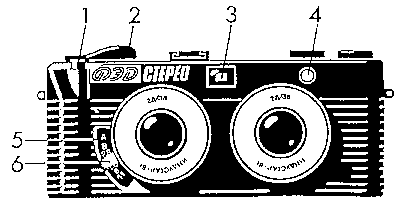 | |
| Fig. 1 - Front of the camera | |
| 1 - release button 2 - shutter cocking lever 3 - viewfinder window |
4 - light port 5 - operation mode scale 6 - operation mode selector |
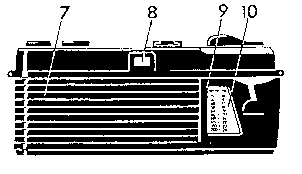 |
| Fig. 2 - Back of the camera |
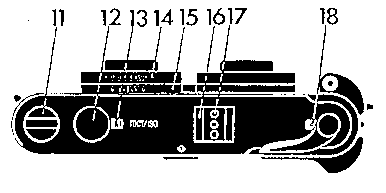 | |
| Fig. 3 - Top of the camera | |
| 11 - rewinding head 12 - film sensitivity 13 - film sensitivity 14 - range scale |
15 - focus depth scale 16 - clip 17 - clip look 18 - stereoscopic couple |
Unscrew the cover 21 (Fig. 4) and insert in its place the cell PU53 so that the sign "+" on its body is oriented outwards (for "FED-stereo" cameras). Insert bushing 23 into the cell compartment. Insert the cell SR44 into the bushing so that the sign "+" on its body is oriented outwards (for "FED-stereo M")
Fit the cover back in place.
Caution! It is not allowed to use the cell SR44 for the camera "FED-stereo" and the cell PU53 for the camera "FED-stere M" since this may increase errors of picture taking procedure.
(ed: Use an SR44 battery for the FED BOY stereo)
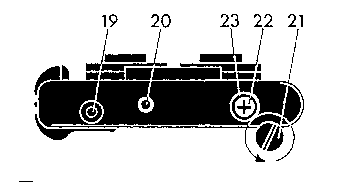 | |
| Fig. 4 - Bottom of the camera | |
| 19 - transport mechanism 20 - stand attachment thread 21 - cell compartment cover 22 - cell | 23 - bushing |
For this, set the mode selector 6 (Fig. 1) to position A. Turn the disk 12 (Fig. 3) to adjust the sensitivity level for 800 units to ISO scale, then turn the shutter lever 2 (Fig. 1) to cock the camera shutter.
Direct the camera at some bright object (such as window or lamp) and gently depress the release button. Interlocing action of the release button indicates that the power source has been fitted in its compartment incorrectly or has become faulty.
Pull up the rewinding head 11 and, while holding it in this position, remove the rear cover 7 from the camera as shown in Fig. 5 by solid arrows. Load the cassette 24 with a film in the camera and release the rewinding head down.
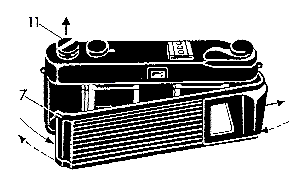 | |
| Fig. 5 - Removing the rear cover |
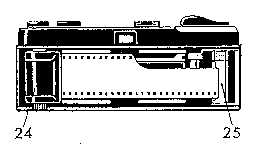 |
| Fig. 6 - Loading film in the camera |
| 24 - cassette loaded with film 25 - receiving coil |
After ensuring that the camera is tightly closed, do as follows:
To wind up the exposed part of the film and to set the counter of the stereoscopic couples to position "1", cock the shutter lever until the cocking lever is interlocked. Now the camera is ready for taking pictures of the first stereoscopic couple.
To facilitate handling of the camera, the shutter cocking lever has two positions - working positions and transporting positions. As set to the working position, the end of the lever extends beyond the shield of the camera.
To shift the lever from the working position to the transporting position, press gently its extending part.
Turn the disk 12 (Fig. 3) to set up the required film sensitivity index. Films sensitivity reference table is given below:
| FOCT units (before 1987) | FOCT/ISO units (after 1987) |
|---|---|
| 16 | 16/22 |
| 22 | 25 |
| 32 | 32/40 |
| 45 | 50 |
| 65 | 64/80 |
| 90 | 100 |
| 130 | 125/160 |
| 180 | 200 |
| 250 | 250/320 |
| 350 | 400 |
| 500 | 500/640 |
| 700 | 800 |
| The camera is equipped with a system of carrying belts (one long belt and two short belts), two clasps, and stiff cover. Link the belts as shown in Fig. 7a and Fig 7b.
|
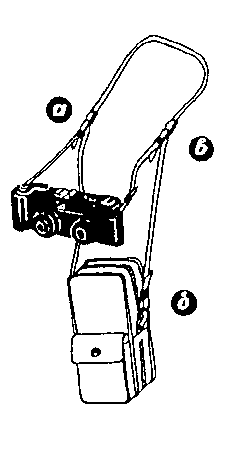 |
By suitably shifting the two clasps along the long belt, adjust the camera for height so that the short belts are long well enough to permit the camera to be held at the eyes level during photographing. When carrying the camera in the case, the clasps are pulled down along the long belt so that the short belts do not cause obstacles to placing the camera in the case (Fig. 8).
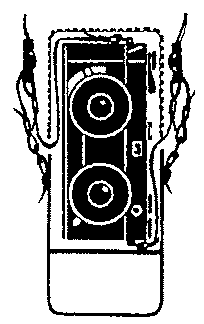 |
Fasten the case with a zipper. As desired, a photographer may adjust the belts in other way to make another combination of belts most convenient to his own taste as shown in Fig. 9.
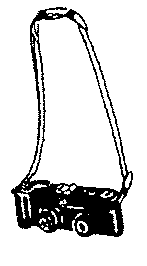 |
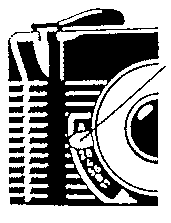 |
Remove the protective cap from the lenses. Set the mode selector 6 (Fig. 10) to position "A".
Select an object for photographing and set the required distance range rotating the range scale 14 (Fig. 3). While observing through the viewfinder the exposure boundaries (those outlined by the illuminated exposure-limiting frame 26) depress gently the release button. If the object intended for photograhing is 1-2m (3.3 - 6.6 ft) away from the camera, the exposure boundaries will be limited by the upper edge of the frame 27 by the side edges of frame 26 and by the lower edge of the viewfinder field of vision (shown in Fig. 11 by a dash line). A stereoscopic effect in this case will be enabled within the exposure part limited by frame 27 and the lower edge of the viewfinder field of vision. The automatic mechanism of the camera will assure the required picture taking procedure. If illumination intensity is low, the release button will be interlocked and the shutter will not operate ("low illumination" interlocking).
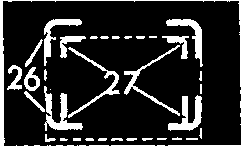 |
CAUTION! Do not apply force when handling the camera with the release button interlocked, because this may cause damage to the camera.
After taking picture of the first stereoscopic couple and any other odd-number stereoscopic couple, push once the cocking lever to a stop. After taking picture of the second stereoscopic couple and any other even-number stereoscopic couple, push the cocking lever to a stop thrice, the release button being interlocked during the first and the second cocking cycles to prevent accidental overlap of the exposures.
CAUTION. To ensurea failure-free operation of the camera, remember to check, before releaseing the button, that the shutter is cocked to a stop (the cocking lever is interlocked). Only then depress the release button. If the release button remains interlocked in the automatic mode, it means that illumination intensity is low. The counter of the stereoscopic couples indicates the number of the stereoscopic couples photographed (black points and numerals) as well as the interlocking of the cocking lever because of being undercocked (red symbols without numerals).
When photographing the objects which are well extended in depth or when photographing a series of objects found afar at various distances, use the focus depth scale 15 (Fig. 12).
 |
The focus depth scale consists of two diaphragms which are symmetrically arranged relative to the range scale index 28 (Fig. 12). When focusing the camera lenses, the focus depth scale indicates on the range scale the maximum and minimum distances from the camera within which limits of the image will be of good quality with any lens stop set during photographing.
For example, in Fig. 12 you may see that with the lens focused at 3m (10 ft) distance with the lens stop set to 8, all the objects found within 2m to 5m (6.6 - 16.5 ft) away from the camera will produce a sharp image on the film as developed. With the lens stop set to 16, the objects found within 1.5m (5 ft) to the point of infinity will produce a sharp image on the film.
White marks 29 on the focus depth scale indicate on the range scale distances from the camera to objects found within the very close and most remote shots when focusing the camera lens at the required range. Within this range of distances, a stereoscopic effect will be the most expressive and the very close to the natural perception, when viewing the stereoscopic image. To set up the best conditions for the stereoscopic effect perception, it is desirable that boundaries of this range (boundaries of the best stereoscopic viewing) are to be within the limits of focus depth. From this point of view, the most convenient combination of parameters, at photographing, is 6.5m (20 ft) distance set with the lens stop set to 5.6m (or any larger number); in this case, indicated boundaries will mark the space of objects found within 3 odd m (10 ft) to infinity and will coincide with boundaries of the sharp pictured space.
A photographer may set the required lens stop number only when the camera is in the manual mode of operation. However, it does not mean that one should refuse from the automatic mode of operation. Long-term practice of operation with the camera "FED-stereo" demonstrate that at any set of exposure values and distance pictures, obtained by the camera, produce (when being viewed) the fully perceptible three-dimensional image pictures of high quality.
NOTE: It should be noted that the afore-said is only true when conditions of viewing of the stereoscopic image imitate exactly conditions of natural observation of the photographed picture (for example, when viewing stereoscopic pictures through a stereoscope which lens focal length is equal to the lens focal length of the camera or when viewing pictures on a screen through a stereoscope from the distance be equal to the doubled width of the image). Otherwise, the really visible limit of the best stereoscopic viewing may not coincide with the limit marked by white mark 29.
When using the pulse flash bulbs of old modifications (cable connected types), use a special adapter.
IMPORTANT! To obtain a quality stereoscopic image, the lens stops within 2.8 to 8 are recommended to be set.
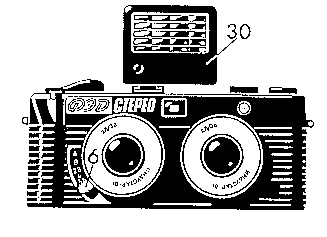 |
Shift aside the arm of the rewinding head, rewind the film back into the cassette (Fig. 14). Open the rear cover and remove the cassette with the exposed film. The film transport mechanism will be engaged automatically as the shutter lever is cocked initially.
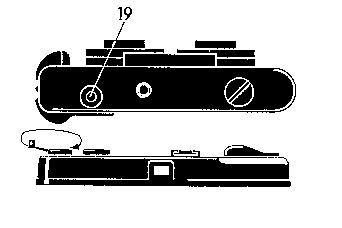 |
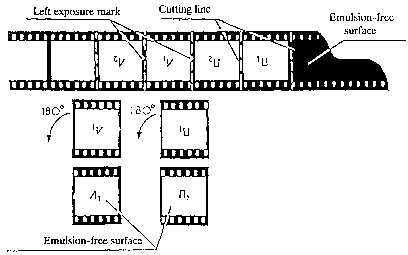 |
Fit the right exposure and the left exposure of the stereoscopic couple into the plastic frames as follows.
The frame consisting of two half-frames of different colours (Fig. 16) should be split into two pieces.
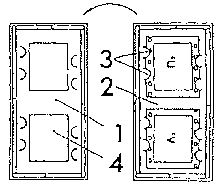 |
Insert the stereoscopic couples in one of the half-frames into the slots 3 (Fig. 16) and position them as shown in Fig. 15c.
To facilitate the assembly procedure it is recommended that the half-frames intended for the stereoscopic couples should be of the same colour.
Move the stereoscopic couple exposure within the slots 3 (Fig. 16) so as to arrange their edges symmetrically to the half-frame windows. Then cover the half-frame 1 with the half-frame 2 and then lock them together. The protective glasses 4 fixed in the half-frame windows should be clean. To assure this requirement, before mounting the glasses wipe them with a piece of flannel cloth. To remove fat stains, use a cotton wad moistened with alcohol or other.
The stereoscopic exposures should be also clean. To prevent finger imprints and/or scratches on the film exposures, do not apply fingers, forceps, and other tools within the zone of the picture image.
It should be borne in mind that the quality of a stereoscopic effect depends largely on the quality of the stereoscopic couples assembly.
NOTE: The stereoscopic frames are not included in the camera delivery set. These frames should be either purchased or made by a photographer using a solid cardboard for this purpose.
It is strongly recommended that the film exposure should include within it's field of vision the objects located at different distances relative to the camera and relative one to another, i.e. the scenes with a deep background.
The least stereoscopic effect is produced by the pictures of a long shot (small-scale pictures). To make such pictures more vivid, bring some picturesque features into the foreground of the scene such as flowers, bushes, grass, etc. However, these features should not be located close to the exposure edges (left or right side), they should be brought possbily close to the exposure centre where the stereoscopic effect of close shots is more stressed.
The best stereoscopic effect is produced when photographing the objects found within 2 to 10 m (6.6 - 33 ft) away from the camera.
Handle the camera with care, do not apply excessive force to it, protect it from dust.
When preparing the camera for operating, push the shutter cocking lever to a stop, otherwise the lever will not return to its initial position which is an indication that the shutter has not been cocked.
Do not depress the release button until the film is completely transported. Rotation of the rewinding head, as the shutter is being cocked, is an indication that the film is being transported normally.
When taking pictures with use of the light filters, pay due regard to a ratio power of the film in use, the correction factor being introduced by suitably varying the film sensitivity degree.
The procedure for taking pictures in an automatic mode applies to most frequent medium illumination of the objects (such as those that are seen against the snowy background, sky, or dark green) introduce a correction factor by changing the degree of film sensitivity by 1-2 divisions (decreasing it for the first two cases and increasing it for the last case).
In order not to forget the actual sensitivity of the film loaded in the camera, it is recommended that the sensitivity indicated on the film packing box should be cut out and placed in the pocket on the rear cover of the camera where the sensitivity conversion table 10 is provided (Fig. 2).
Remember the actual value of the film sensitivity.
When taking pictures against a background of a light source, use a lens hood.
To extend the service life of the power cell, when taking pictures outdoors during freezing weather hide the camera under a coat (if temperature is below 0C) and take it out only when taking pictures.
If required, clean the optical surfaces of the lenses and of the viewfinder by gently wiping them with a piece of flannel cloth or with a cotton wad slightly moistened with alcohol. To remove dust, use brush.
Protect the camera against shocks, dust, humidity and sharp temperature variations. Keep the camera in the case with the protective caps fitted on its lenses and the shutters released if possible.
If the camera is kept inoperative for a long time, remove the power cell from its compartment and keep it separately from the camera.
| Trouble | Cause | Remedy |
|---|---|---|
| As set to automatic operation mode, the camera shutter fails to operate even though the picture object is brightly illuminated | The power cell is faulty: -polarity is set incorrectly when loading the cell | Remove the power cell from the compartment, rearrange its polarity and load it back (see Fig. 10) | The power cell is exhausted | Replace the power cell by a new one (Fig. 10) | Surface of the power cell or contact in the cell compartment has become oxidized | Brush slightly the surface of the power cell or contact in the cell compartment. |
| As the shutter leveris being cocked, the film rewinding head stands still. | The film fails to be transported due to its improper loading. | Open the rear cover of the camera and reload the film properly (see Fig. 14) |